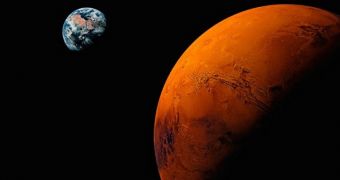Researcher Gregory Retallack with the University of Oregon in the United States claims to have uncovered new evidence that, a long time ago, Mars might have accommodated for microbial life.
In a paper published in the online journal Geology earlier this week, the scientist explains that, while looking at images provided by NASA's Curiosity rover, which is now exploring the Red Planet, several photos of the Gale crater caught his eye.
What sparked Gregory Retallack's interest was soil lying at the bottom of this 3.7-billion-year-old impact crater. Thus, the University of Oregon geologist argues that, as revealed by the Curiosity rover, this soil is surprisingly Earth-like.
More precisely, it looks like its cracked surfaces lined with sulfate, together with its ellipsoidal hollows and its concentrations of sulfate, make soil deep in Mars' Gale Crater similar to dirt in Chile's Atacama Desert and Antarctica's Dry Valleys.
“None of these features is seen in younger surface soils of Mars. The exploration of Mars, like that of other planetary bodies, commonly turns up unexpected discoveries, but it is equally unexpected to discover such familiar ground,” the geologist argues.
In light of these findings, the University of Oregon specialist argues that, all things considered, the Red Planet was once a much warmer and wetter environment. Hence, it could be that, at some point in its history, it even accommodated for microbial life.
“The new data show clear chemical weathering trends, and clay accumulation at the expense of the mineral olivine, as expected in soils on Earth. Phosphorus depletion within the profiles is especially tantalizing, because it attributed to microbial activity on Earth,” the researcher explains.
Truth be told, the discovery of Earth-like soils on Mars is by no means bullet-proof evidence that the Red Planet was once teemed with microbial life. The find does however indicate that, a long time ago, the planet was way more hospitable than it currently is.
In a recent interview, Gregory Retellack wished to stress that, although it was he who authored the paper in the journal Geology, NASA's Curiosity rover should receive due credit for having delivered accurate and detailed information concerning Mars' makeup.
“The pictures were the first clue, but then all the data really nailed it. The key to this discovery has been the superb chemical and mineral analytical capability of the Curiosity Rover, which is an order of magnitude improvement over earlier generations of rovers,” the geologist said in a statement.

 14 DAY TRIAL //
14 DAY TRIAL //